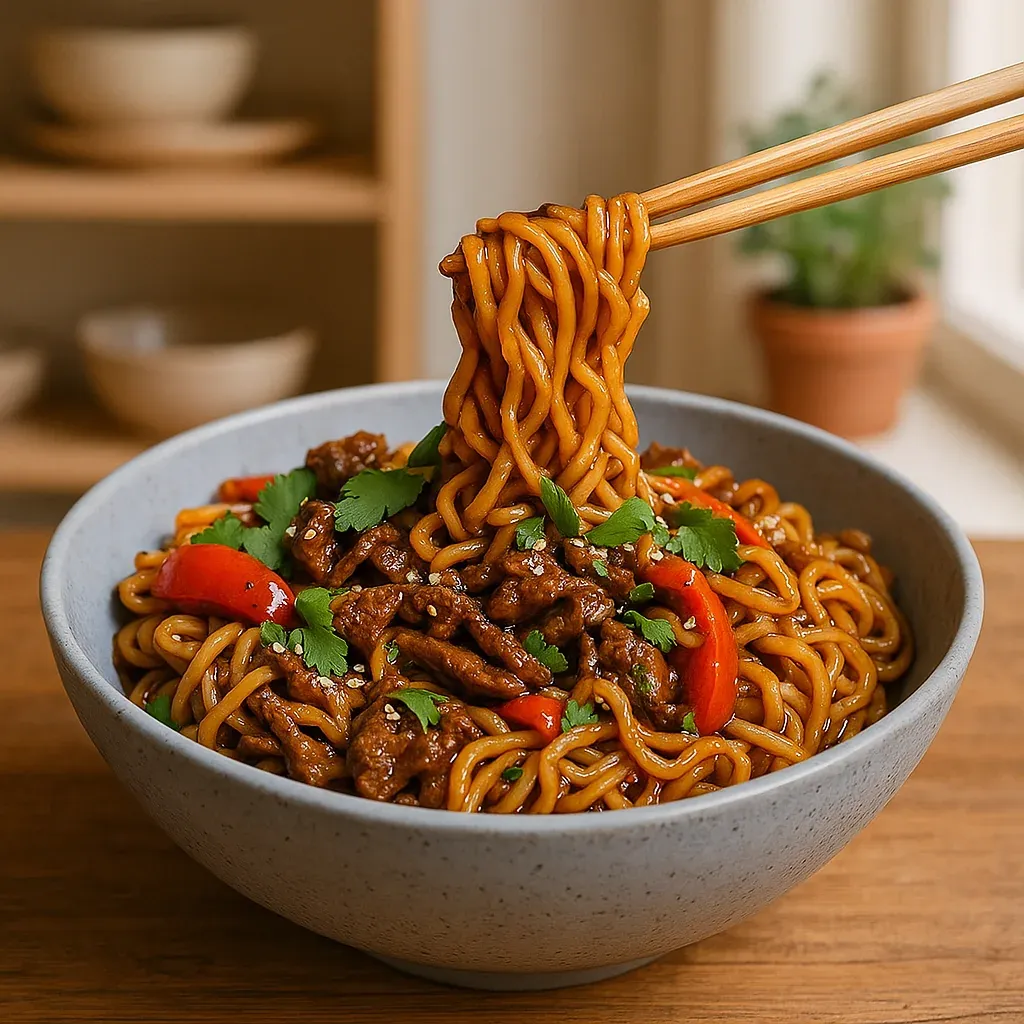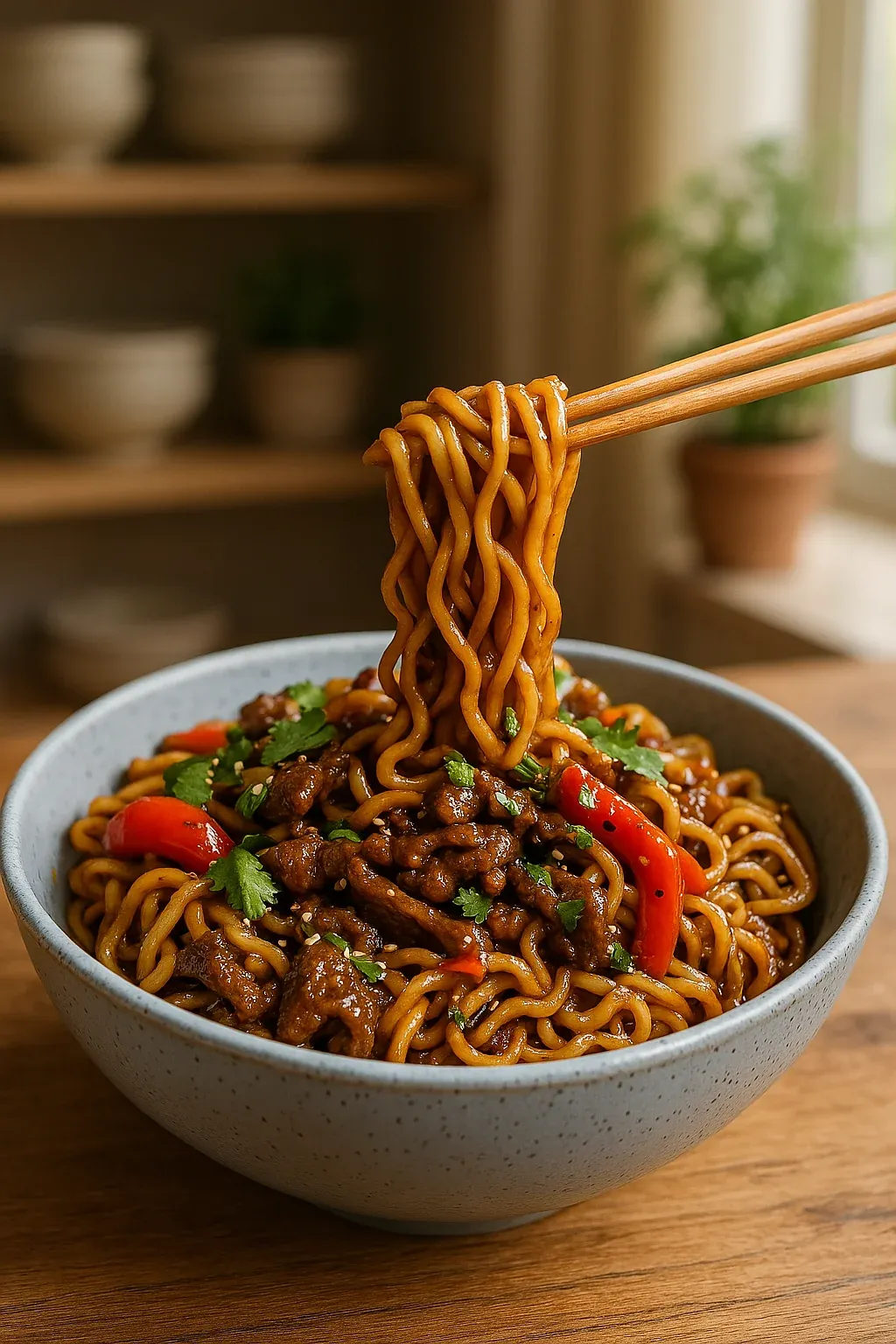 Pin
Pin
This hearty hoisin beef noodle dish has become my go-to recipe for busy weeknights when I crave something satisfying yet quick to prepare. The combination of tender beef strips, vibrant vegetables, and noodles all coated in that rich, sweet-savory hoisin sauce creates a restaurant-worthy meal right at home.
I first created this recipe during a particularly cold winter when I was craving comfort food with bold flavors. My family immediately requested it join our regular dinner rotation, and it has since become our favorite way to use up leftover vegetables and proteins.
- Beef sirloin or flank steak: Thinly sliced against the grain for maximum tenderness
- Rice noodles or egg noodles: Cook quickly and absorb the delicious sauce beautifully
- Hoisin sauce: Provides the signature sweet and savory base flavor for this dish
- Soy sauce: Adds umami depth and balances the sweetness of the hoisin
- Fresh garlic and ginger: Create an aromatic foundation that elevates all other flavors
- Red bell peppers: Bring sweetness and vibrant color to the finished dish
- Carrots: Add a pleasant crunch and natural sweetness when quickly stir-fried
- Green onions: Provide a mild onion flavor and fresh green color as garnish
- Sesame seeds: Offer a nutty flavor and appealing visual texture when sprinkled on top
- Cilantro: Brings a bright, fresh finish that cuts through the richness of the sauce
Step-by-Step Instructions
- Prepare the Marinade:
- Whisk together 4 tablespoons hoisin sauce, 2 tablespoons soy sauce, 3 cloves minced garlic, and 1 tablespoon grated ginger in a bowl until completely blended. The marinade should have a thick, glossy consistency with visible bits of garlic and ginger distributed throughout. This flavorful mixture will both tenderize and infuse the beef with amazing taste.
- Marinate the Beef:
- Place 500g thinly sliced beef in a bowl and pour the marinade over it. Use tongs or your hands to ensure every piece of meat is thoroughly coated. Allow the beef to marinate for at least 15 minutes at room temperature or up to 4 hours in the refrigerator for deeper flavor penetration. The longer it marinates, the more tender and flavorful your beef will become.
- Cook the Noodles:
- Bring a large pot of water to a rolling boil over high heat. Add 400g of noodles and cook according to package directions until just al dente. For rice noodles, this is typically 3-4 minutes. Be careful not to overcook as they will continue to soften when added to the stir fry later. Drain immediately and rinse under cold water to stop the cooking process and prevent sticking.
- Stir Fry the Vegetables:
- Heat a large wok or skillet over high heat until very hot, then add 1 tablespoon vegetable oil. Add julienned carrots and sliced red bell pepper, stir-frying continuously for about 2 minutes until they begin to soften but still maintain their crunch. The high heat will help caramelize the natural sugars in the vegetables while keeping them vibrant and crisp.
- Cook the Beef:
- Push vegetables to one side of the pan and add another tablespoon of oil to the empty space. Add the marinated beef in a single layer, allowing it to sear untouched for 30 seconds before stirring. Continue cooking for 3-4 minutes until the beef is browned on the outside but still slightly pink inside. The beef will finish cooking when combined with the hot noodles and vegetables.
- Combine Everything:
- Add the cooked noodles to the pan along with any remaining marinade. Using tongs, gently toss everything together for 2-3 minutes until the noodles are heated through and evenly coated with sauce. The residual heat will continue cooking the beef to perfection while the noodles absorb the flavorful sauce. If the mixture seems dry, add 2-3 tablespoons of water to create more sauce.
- Garnish and Serve:
- Remove from heat and sprinkle with chopped green onions, toasted sesame seeds, and fresh cilantro. For an extra flavor boost, drizzle with a small amount of sesame oil just before serving. The aromatic garnishes not only add visual appeal but provide fresh flavor counterpoints to the rich, savory dish.

My favorite component of this dish is undoubtedly the hoisin sauce. I remember the first time I cooked with it years ago, I was utterly amazed at how this single ingredient could transform simple ingredients into something so complex and delicious. Now I always keep a jar in my refrigerator for quick flavor boosts to everyday meals.
Make-Ahead Tips
This hoisin beef noodle recipe works wonderfully for meal planning scenarios. You can prepare several components ahead of time to make the final cooking process even quicker. The beef can be sliced and marinated up to 24 hours in advance, which not only saves time but also results in more flavorful meat. Store the marinated beef in an airtight container in the refrigerator until ready to cook.
Similarly, all vegetables can be chopped and stored in sealed containers in the refrigerator for up to two days before cooking. The noodles can even be cooked a day ahead, tossed with a small amount of oil to prevent sticking, and refrigerated until needed. When ready to serve, simply warm them briefly in hot water before adding to the stir fry.
Storage and Leftovers
The completed hoisin beef noodle dish stores beautifully in airtight containers in the refrigerator for up to three days. To reheat, add a splash of water or chicken broth to the noodles before warming them in a skillet over medium heat. This helps revitalize the sauce and prevents the noodles from drying out. Stir frequently while reheating to ensure even warming and to prevent sticking.
For longer storage, this dish can be frozen for up to two months. When freezing, slightly undercook the noodles as they will soften further during the reheating process. Thaw overnight in the refrigerator before reheating thoroughly in a skillet or microwave with added moisture.

Ingredient Substitutions
This versatile recipe welcomes numerous adaptations based on dietary preferences or ingredient availability. For a vegetarian version, substitute the beef with firm tofu, tempeh, or a variety of mushrooms like shiitake or portobello. The meaty texture of these fungi makes them particularly suitable replacements for the beef while still absorbing all the delicious flavors of the marinade.
Those following a gluten-free diet can use rice noodles and ensure their hoisin and soy sauces are certified gluten-free. Most grocery stores now carry gluten-free versions of these Asian condiments. For a lower carb option, try using spiralized vegetables like zucchini or shirataki noodles instead of traditional wheat or rice noodles.
The sauce itself can be adjusted according to taste preferences. If you enjoy spice, add a teaspoon of chili garlic sauce or sriracha to the marinade. For a more complex flavor profile, include a tablespoon of oyster sauce or a splash of Chinese rice wine during cooking.
The Cultural Background
Hoisin beef noodles represent a beautiful fusion of traditional Chinese flavors and modern cooking techniques. Hoisin sauce originated in Cantonese cuisine, where it was traditionally used as a glaze for roasted meats like duck and pork. The name "hoisin" comes from the Chinese word for seafood, though interestingly the sauce contains no seafood ingredients. Instead, it typically features fermented soybeans, garlic, various spices, and sweeteners.
This particular preparation style, combining stir-fried beef with noodles and a rich sauce, draws inspiration from several regional Chinese cooking traditions. The emphasis on quick cooking over high heat preserves the fresh flavor and texture of the ingredients while creating a harmonious melding of tastes. This approach to cooking was born from necessity in times when fuel was precious, but has endured because of the exceptional results it produces.
Recipe FAQs
- → What type of beef works best for Hoisin Beef Noodles?
Thinly sliced cuts such as sirloin, flank, or ribeye are ideal as they cook quickly and remain tender.
- → Can I make this dish vegetarian?
Absolutely! Swap the beef for tofu, tempeh, or seitan, and choose vegetarian-friendly hoisin sauce.
- → What noodles should I use?
Rice noodles or egg noodles work best, but you can also try soba, udon, or even zucchini noodles for variety.
- → How can I add more vegetables to the dish?
Include crunchy options like broccoli, mushrooms, or snow peas, or experiment with seasonal produce.
- → How do I prevent noodles from sticking together?
Rinse the cooked noodles under cold water and toss them with a bit of oil to keep them separate.
- → Can I adjust the spice level?
Yes! Add chili flakes, sriracha, or fresh sliced chilies to increase the heat according to your preference.
